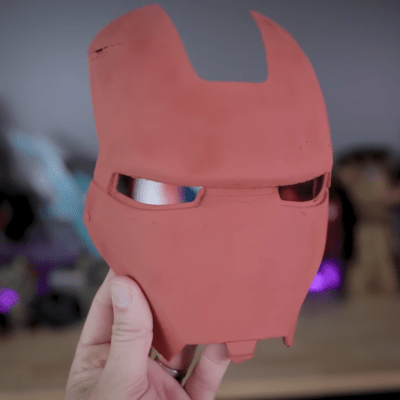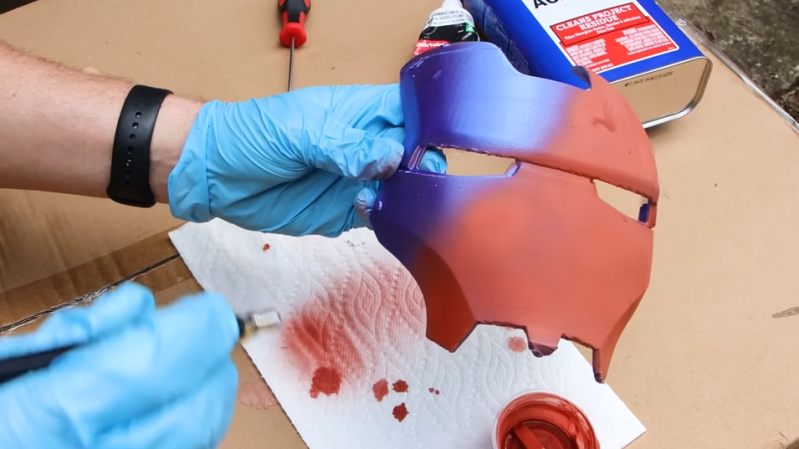3D prints destined for presentation need smooth surfaces, and that usually means sanding. [Uncle Jessy] came across an idea he decided to try out for himself: spraying Bondo spot putty onto a 3D print. Bondo spot putty comes from a tube, cures quickly, and sands smoothly. It’s commonly used to hide defects and give 3D prints a great finish. Could spraying liquified Bondo putty onto a 3D print save time, or act as a cheat code for hiding layer lines? [Uncle Jessy] decided to find out.

The first step is to turn the distinctive red putty into something that can be sprayed through a cheap, ten dollar airbrush. That part was as easy as squeezing putty into a cup and mixing in acetone in that-looks-about-right proportions. A little test spray showed everything working as expected, so [Uncle Jessy] used an iron man mask (smooth surfaces on the outside, textured inside) for a trial run.
Spraying the liquified Bondo putty looks about as easy as spraying paint. The distinctive red makes it easy to see coverage, and it cures very rapidly. It’s super easy to quickly give an object an even coating — even in textured and uneven spots — which is an advantage all on its own. To get a truly smooth surface one still needs to do some sanding, but the application itself looks super easy.
Is it worth doing? [Uncle Jessy] says it depends. First of all, aerosolizing Bondo requires attention to be paid to safety. There’s also a fair bit of setup involved (and a bit of mess) so it might not be worth the hassle for small pieces, but for larger objects it seems like a huge time saver. It certainly seems to cover layer lines nicely, but one is still left with a Bondo-coated object in the end that might require additional sanding, so it’s not necessarily a cheat code for a finished product.
If you think the procedure might be useful, check out the video (embedded below) for a walkthrough. Just remember to do it in a well-ventilated area and wear appropriate PPE.
An alternative to applying Bondo is brush application of UV resin, but we’ve also seen interesting results from non-planar ironing.
















I like Speedokote High Build Primer, but there are a ton of automotive filler primers that you could go with. if you dont want to mess around with blending your own.
Sprayed acetone… sounds risky
Only if you fail to follow basic safety precautions but thats neither here nor there, Speedokote High Build Primer doesnt contain acetone. Not that its any safer to use around ignition sources or without proper PPE.
There’s a lot of high-build primers and “finishing filler” in both aerosol cans and for dilution and subsequent spraying with a classic spray gun.
Though you’d have to look around since that’s predominantly targeted the semi-professional to professional market.
Hell, there’s even high-build primer meant specifically for ABS and glasfiber bodywork which AFAIK also works with most other plastics.
acetone spray seems awfully combustible to me ….
so avoid open flames. Problem solved
no, not problem solved, risk concealed.
No. Problem solved. Its not a concealed risk. Its common knowledge that acetone is flamable. There are warnings and symbols on the bottles as well. Avoiding open flames is pretty much standard protocol with MOST spray applications of MOST solvents.
The benefit of a respirator is that it prevents the user from smoking a cigarette when spraying it. Another thing with acetone is that it’s great for smoothing ABS prints, so you could i that case leave out the bondo.
If you get a dual filter respirator you can 3d print a cigarette/joint/crackpipe adaptor to take the place of one of the the filters.
You have to seal the other filter with your hand to get good draw.
Friends with union painters…
Second proudest moment as pot grower…
‘Too strong’ for union painters to paint after smoking, not that they paint much in any case.
That was original ‘Trainwreck’.
Also friends with a car painter, you need a serous positive pressure respirator for some paints.
Those are hard to smoke in.
Bet vape adaptors have been built.
Acetone is less flammable than you’d guess. I attempted to set a half full can of acetone on fire (after tipping it over to get max vapors) as a kid and was very surprised to only get a wimpy flame – it’s no where near something like gas or butane, or even 40% alcohol.
I’m sure you can get a big flare if you’re not in a well ventilated area, but otherwise the risk is pretty low. Acetone is heavier than air and can pool in low areas if there is no airflow.
Most spray cans have flammable propellants, many using really flammable stuff. I really don’t see any unreasonable risk if you have ppe and a fire extinguisher nearby.
Exactly! My current anti-perspirant uses propane as a propellent. I bet if you used it as a field-expedient flamethrower it would be quite spectacular.
Wear proper flame protection before trying this!
I blame Bond films for all the spray can flamethrowers I played with as a kid.
Nobody got hurt much, nothing got burnt we didn’t intend to burn.
It is, so don’t spray it on an open flame. Acetone is a great thinner for spray coatings. Evaporates almost instantly, so whatever you’re spraying ends up with the same consistency it originally had by the time it gets to the surface.
Of course it’s combustible, but so is pretty much every solvent used to thin non-water-based paint.
If that was an unmanageable risk, commercial spraypaint cans wouldn’t exist – not only are they full of flammable solvents, but they almost always use propane or butane as a propellant.
Check the SDS for something like Krylon Fusion – not only is it up to 50% acetone and 25% butane, but it’s hard to figure out what part of the rest is not incredibly flammable. The paint color (<1%) is about the only thing that isn’t a flammable gas or liquid, and depending on the color it may still be a flammable solid.
The video is ~3 years old now but the technique works well. In the video Uncle Jessy doesn’t use goggles but I would recommend them.
Man reinvents spray primer, hackaday writers amazed.
Yeah OK this works, and kudos for doing it outside, but like… I’m not sure this solves a problem or saves money over a regular high build primer, and having a pot life to worry about, and cleanup…. Now put some serious amount of chopped up fiberglass in there and we’re talking about something else all together evil and wonderful. Maybe in the next installment?